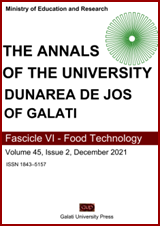In vitro antioxidant potential and antimicrobial activity of some Cameroonian plant extracts
Abstract
A study on Cameroonian edible and medicinal plants was undertaken to assess their potential as food preservatives and natural food colorants. The ultrasound-assisted technique was used for the extraction of bioactive compounds. A total of 16 extracts prepared from 7 plants (Aframomum melegueta S., Ageratum conyzoides L., Cympobogon citratus Stapf, Garcinia kola Heckel, Lantana camara L., Nauclea diderrichii, Vernonia amygdalina) were assayed to detect phytochemicals and assess antioxidant potential using the scavenging DPPH radical method and antimicrobial activity (10 mg/mL) against ten microorganisms by the agar well diffusion method. The ethanolic extract from L. camara leaves revealed the highest polyphenols and flavonoids contents. In contrast, the hexane/acetone extract from A. conyzoides and L. camara leaves had the highest chlorophyll a (Chl a) and chlorophyll b (Chl b) contents, whereas the highest carotenoid content was found in L. camara leaves. The ethanol extracts exhibited more significant antioxidant activity than hexane/acetone extracts. All seven plants (100%) inhibited the growth of at least one tested foodborne and spoilage bacteria and fungi. The germination of both Bacillus spp. spores were also affected. The hexane/acetone extracts were by far the best antimicrobial agent, and extract from L. camara leaves was one of the most effective, with a large antimicrobial spectrum. The antimicrobial activity of extracts was correlated to the amount of carotenoids and chlorophylls. HPLC-DAD revealed bioactive compounds as chlorogenic and caffeic acids found as major phenols in ethanolic extract of L. camara leaves, whereas lutein, carotene, and zeaxanthin were the specific carotenoids present in hexane/acetone extract of the same plant.


